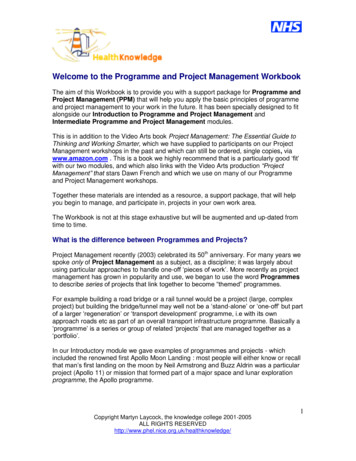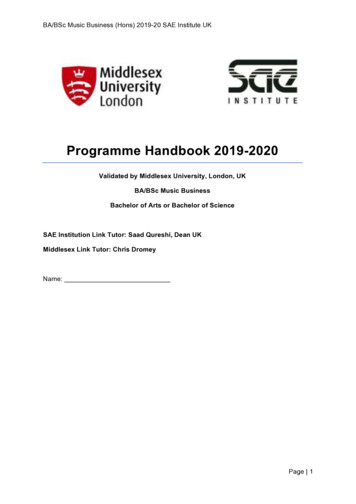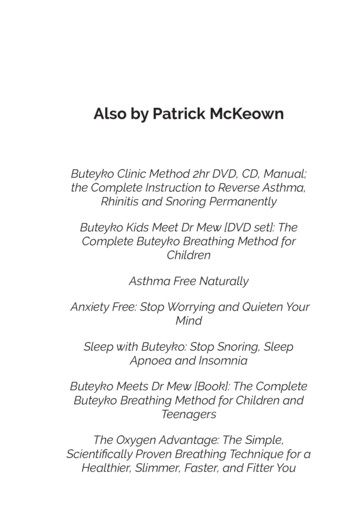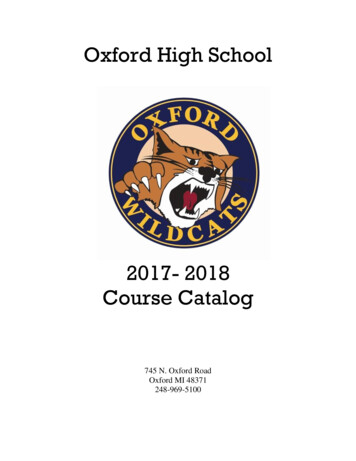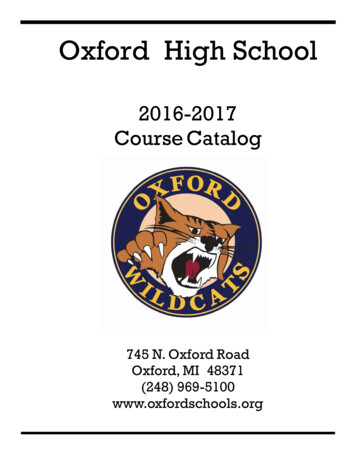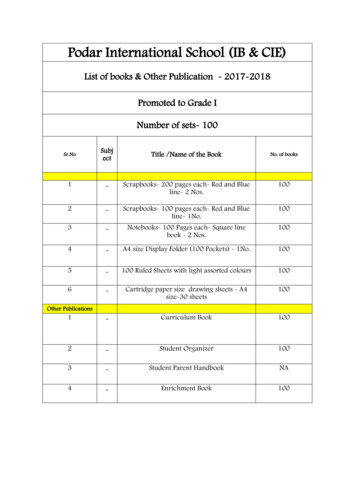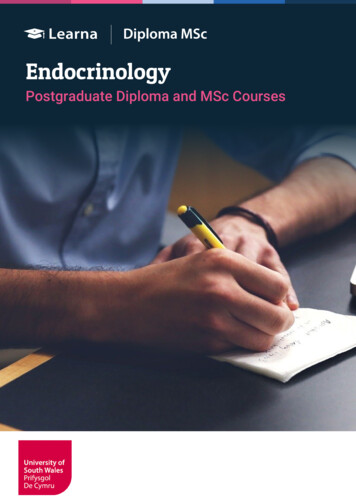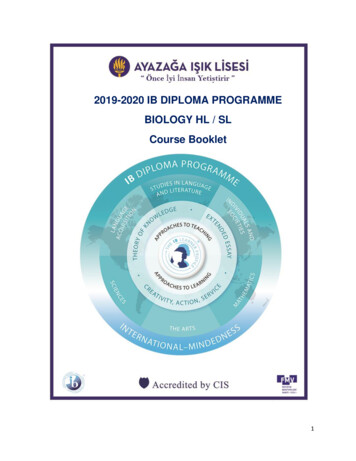
Transcription
2019-2020 IB DIPLOMA PROGRAMMEBIOLOGY HL / SLCourse Booklet1
TABLE OF CONTENTS – BIOLOGY HL / SLINTRODUCTION . 3BIOLOGY and NATURE OF SCIENCE (NOS) . 3BIOLOGY and THEORY OF KNOWLEDGE (TOK) . 4BIOLOGY and INTERNATIONAL MINDEDNES (IM) . 4THE IB LEARNER PROFILE . 5GROUP 4 AIMS . 6IB BIOLOGY SYLLABUS OUTLINE . 7SEQUENCE OF TOPICS (HL / SL) . 8MATHEMATICAL REQUIREMENTS. 9THE ASSESSMENT OBJECTIVES . 9ASSESSMENT OUTLINE—SL . 10EXTERNAL ASSESSMENT DETAILS—SL . 10ASSESSMENT OUTLINE—HL . 11EXTERNAL ASSESSMENT DETAILS—HL . 11Bioology HL/SL Grade Boundaries (Nov 2018 Subject Report) . 12INTERNAL ASSESSMENT (BOTH SL/HL) . 13The Seven Prescribed (Required) Laboratory Investigations for IB Biology HL / SL . 14THE GROUP 4 PROJECT . 15SCHOOL BASED ASSESSMENTS . 15COMMAND TERMS FOR BIOLOGY . 16LESSON MATERIALS . 18WEB LINKS . 18Course Teacher: Volkan SERİN – volkan.serin@fmvisik.k12.tr6 hours of lecture per week2
INTRODUCTIONBiology is the study of life.The first organisms appeared on the planet over 3 billion years ago and, throughreproduction and natural selection, have given rise to the 8 million or so differentspecies alive today. Estimates vary, but over the course of evolution 4 billion speciescould have been produced. Most of these flourished for a period of time and then becameextinct as new, better adapted species took their place. There have been at least fiveperiods when very large numbers of species became extinct and biologists areconcerned that another mass extinction is under way, caused this time by human activity.Nonetheless, there are more species alive on Earth today than ever before. This diversitymakes biology both an endless source of fascination and a considerable challenge.Biologists attempt to understand the living world at all levels using many differentapproaches and techniques. At one end of the scale is the cell, its molecularconstruction and complex metabolic reactions. At the other end of the scale biologistsinvestigate the interactions that make whole ecosystems function.There are a variety of approaches to the teaching of biology in the Diploma Programme.By its very nature, biology lends itself to an experimental approach, and it is expectedthat this will be reflected throughout the course.Group 4 students at standard level (SL) and higher level (HL) undertake a common coresyllabus, a common internal assessment (IA) scheme and have some overlappingelements in the option studied. They are presented with a syllabus that encourages thedevelopment of certain skills, attributes and attitudes, as described in the “Assessmentobjectives” section of the guide.BIOLOGY and NATURE OF SCIENCE (NOS)The Nature of Science (NOS) is an overarching theme in the biology, chemistry andphysics courses. Below mentioned how one or more of the NOS themes can beexemplified through the understandings, applications and skills in that particular topic.You should be familiar with NOS statements which will be mentioned in textbooks.Topic 2 : Molecular biologyNOS Statement2.1 Molecules to metabolismFalsification of theories—the artificial synthesis ofurea helped to falsify vitalism. ( 1.9)1.9. This evidence is used to develop theories, generalize from data to form laws and propose hypotheses.These theories and hypotheses are used to make predictions that can be tested. In this way theories canbe supported or opposed and can be modified or replaced by new theories.3
BIOLOGY and THEORY OF KNOWLEDGE (TOK)TOK lessons support students in their study of science, just as the study of sciencesupports students in their TOK course. An example for TOK statement in biology courseis below.Topic 2 : Molecular biologyTOK Statement2.2 WaterClaims about the “memory of water” have beencategorized as pseudoscientific. What are thecriteria that can be used to distinguish scientificclaims from pseudoscientific claims?BIOLOGY and INTERNATIONAL MINDEDNES (IM)Science itself is an international endeavor-the exchange of information and ideas acrossnational boundaries has been essential to the progress of science. An example for IM inbiology course is below.Topic 2 : Molecular biologyIM Statement2.2 WaterThere are challenges for the increasing humanpopulation in sharing water resources equitably fordrinking and irrigation, electricity generation and arange of industrial and domestic processes.4
THE IB LEARNER PROFILEThe biology course is closely linked to the IB learner profile. By following the course,students will have engaged with the attributes of the IB learner profile. For example, therequirements of the internal assessment provide opportunities for students to developevery aspect of the profile. For each attribute of the learner profile, a number of referencesfrom the Group 4 courses are given below.Learner leBilgiliThinkersDüşünenCommunicatorsİletişim kurabilenPrincipledİlke sahibiOpen-mindedAçık fikirliCaringDuyarlıRisk-takersRisk nenBiology, Chemistry and PhysicsAims 2 and 6Practical work and internal assessmentAims 1 and 10, international-mindedness linksPractical work and internal assessmentAims 3 and 4, theory of knowledge linksPractical work and internal assessmentAims 5 and 7, external assessmentPractical work and internal assessmentAims 8 and 9Practical work and internal assessment. Ethical behaviour/practice(Ethical practice in the Diploma Programme poster, IB animalexperimentation policy), academic honestyAims 8 and 9, international-mindedness linksPractical work and internal assessment, the group 4 projectAims 8 and 9Practical work and internal assessment, the group 4 project,ethical behaviour/ practice (Ethical practice in the DiplomaProgramme poster, IB animal experimentation policy)Aims 1 and 6Practical work and internal assessment, the group 4 projectAims 8 and 10Practical work and internal assessment, the group 4 project andfield workAims 5 and 9Practical work and internal assessment, the group 4 project5
GROUP 4 AIMSThrough studying biology, chemistry or physics, students should become aware of howscientists work and communicate with each other. While the scientific method may takeon a wide variety of forms, it is the emphasis on a practical approach through experimentalwork that characterizes these subjects.The aims enable students, through the overarching theme of the Nature of science, to:1. appreciate scientific study and creativity within a global context through stimulatingand challenging opportunities2. acquire a body of knowledge, methods and techniques that characterize science andtechnology3. apply and use a body of knowledge, methods and techniques that characterizescience and technology4. develop an ability to analyse, evaluate and synthesize scientific information5. develop a critical awareness of the need for, and the value of, effective collaborationand communication during scientific activities6. develop experimental and investigative scientific skills including the use of currenttechnologies7. develop and apply 21st century communication skills in the study of science8. become critically aware, as global citizens, of the ethical implications of using scienceand technology9. develop an appreciation of the possibilities and limitations of science and technology10. develop an understanding of the relationships between scientific disciplines and theirinfluence on other areas of knowledge.6
IB BIOLOGY SYLLABUS OUTLINESyllabus componentCore1. Cell biology2. Molecular biology3. Genetics4. Ecology5. Evolution and biodiversity6. Human physiologyAdditional higher level (AHL)7. Nucleic acids8. Metabolism, cell respiration and photosynthesis9. Plant biology10. Genetics and evolution11. Animal physiologyOptionA. Neurobiology and behaviourB. Biotechnology and bioinformaticsC. Ecology and conservationD. Human physiologyPractical scheme of work (PSOW)Practical activitiesIndividual investigation (internal assessment–IA)Group 4 projectTotal teaching hoursTeaching 52540602040101010101502407
SEQUENCE OF TOPICS (HL / SL)Year 2 (12th Grade)TopicTopicTopic 2: Molecular biologyEE 1st draft submittedSome of the topics 7, 8 and 9Topic 4: EcologyintegratedTopic 5: Evolution and biodiversityGroup 4 Topic ChoiceTopic 10.3 integratedEE Subject ChoicesIA 2nd draftTopic 1: Cell biologyTopics 11.3 and 9.1 integratedSemester - 1Semester - 1Year 1 (11th Grade)EE Interim with the supervisorIA Final copy submittedEE final Copy submittedTopic 3: GeneticsSome of the topics 9 and 10 integratedEE Outline Writing CampREVISION / MOCK EXAMSGroup 4 Project PresentationsMAY 2021 - EXAMSTopic 6: HumansTopics 11 and Opt A integratedIA 1st DraftWriting the EESemester – 2Semester – 2EE Research Question8
MATHEMATICAL REQUIREMENTSAll Diploma Programme biology students should be able to: perform the basic arithmetic functions: addition, subtraction, multiplication anddivisioncarry out calculations involving means, decimals, fractions, percentages and ratiosrepresent and interpret frequency data in the form of bar charts, graphs andhistograms, including direct and inverse proportionplot graphs (with suitable scales and axes) involving two variables that show linearor non-linear relationshipsplot and interpret scatter-graphs to identify a correlation between two variables, andappreciate that the existence of a correlation does not establish a causal relationshipdetermine the mode and median of a set of data, calculate and analyse standarddeviationselect statistical tests appropriate for the analysis of particular data and interpret theresults.THE ASSESSMENT OBJECTIVESThe assessment objectives for biology, chemistry and physics reflect those parts of theaims that will be formally assessed either internally or externally. These assessments willcentre upon the nature of science. It is the intention of these courses that students areable to fulfill the following assessment objectives:1. Demonstrate knowledge and understanding of:a. facts, concepts and terminologyb. methodologies and techniquesc. communicating scientific information.2. Apply:a. facts, concepts and terminologyb. methodologies and techniquesc. methods of communicating scientific information.3. Formulate, analyse and evaluate:a. hypotheses, research questions and predictionsb. methodologies and techniquesc. primary and secondary datad. scientific explanations.4. Demonstrate the appropriate research, experimental, and personal skillsnecessary to carry out insightful and ethical investigations.9
ASSESSMENT OUTLINE—SLEXTERNAL ASSESSMENT DETAILS—SL10
ASSESSMENT OUTLINE—HLEXTERNAL ASSESSMENT DETAILS—HL11
Bioology HL/SL Grade Boundaries (Nov 2018 Subject Report)12
INTERNAL ASSESSMENT (BOTH SL/HL)Internal assessment enables you to demonstrate the application of your skills andknowledge, and to pursue your personal interests, without the time limitations and otherconstraints that are associated with written examinations. The internal assessmentshould, as far as possible, be woven into normal classroom teaching and not be aseparate activity conducted after a course has been taught. Student work is internally assessed by the teacher and externally moderated by theIB.Compulsory for both SL and HL students.Requirements at SL and at HL are the same.Contributing 20% to the final assessment.Must be the student’s own work.Decide upon a title or topic without any further support from the teacher.Teachers and students must discuss the internally assessed work.Teachers should read and give advice to students on one draft of the work.The teacher should provide oral or written advice on how the work could be improved,but not edit the draft.The next version handed to the teacher must be the final version for submission.Academic honesty, authenticity and intellectual property!The internally assessed work must be entirely their own (students).Collaboration between students is permitted.Once a student has officially submitted the final version of the work it cannot beretracted.The content of the work:o the student’s initial proposalo the first draft of the written worko the references citedo the style of writing compared with work known to be that of the studento the analysis of the work by a web-based plagiarism detection service such ashttp://www.turnitin.com.IA TIME ALLOCATIONA total of approximately 10 hours of teaching time for both SL and HL.This should include: time for the teacher to explain to students the requirements of the internalassessment class time for students to work on the internal assessment component and askquestions time for consultation between the teacher and each student time to review and monitor progress, and to check authenticity.40 suggestions for a safer lab!13
Practical work and internal assessmentThe Seven Prescribed (Required) Laboratory Investigations for IBBiology HL / SLPractical 1 Cells unitPractical 4 Metabolism unitUse of a light microscope to investigatethe structure and ultrastructure of cells andtissues, with drawing of cells andcalculation of the magnification ofdrawings and the actual sizes of structuresshown in drawings or micrographsSeparation of photosynthetic pigments bychromatographyPractical 2 Cells unitPractical 6 Human physiologyEstimation of osmolarity in tissues bybathing samples in hypotonic andhypertonic solutionsMonitoring of ventilation in humans at restand after mild and vigorous exercisePractical 5 Ecology unitSetting up sealed mesocosms to trytoestablish sustainabilityPractical 7 Plants unitPractical 3 Molecules of Life unitExperimental investigation of a factoraffecting enzyme activityMeasurement of transpiration rates usingpotometers14
THE GROUP 4 PROJECTThe group 4 project is an interdisciplinary activity in which all Diploma Programme sciencestudents must participate. The intention is that students from the different group 4subjects analyse a common topic or problem. The exercise should be a collaborativeexperience where the emphasis is on the processes involved in, rather than the productsof, such an activity. In most cases students in a school would be involved in theinvestigation of the same topic. Where there are large numbers of students, it is possibleto divide them into several smaller groups containing representatives from each of thescience subjects. Each group may investigate the same topic or different topics—that is,there may be several group 4 projects in the same school. Students studyingenvironmental systems and societies are not required to undertake the group 4 project.The group 4 project allows students to appreciate the environmental, social and ethicalimplications of science and technology. It may also allow them to understand thelimitations of scientific study, for example, the shortage of appropriate data and/or thelack of resources. The emphasis is on interdisciplinary cooperation and the processesinvolved in scientific investigation, rather than the products of such investigation. Thechoice of scientific or technological topic is open but the project should clearly addressaims 7, 8 and 10 of the group 4 subject guides. Ideally, the project should involve studentscollaborating with those from other group 4 subjects at all stages. To this end, it is notnecessary for the topic chosen to have clearly identifiable separate subject components.However, for logistical reasons, some schools may prefer a separate subject “action”phaseSCHOOL BASED ASSESSMENTSThe oral grades (2nd) for MEB reports will be given by using the following criteria.FIRST YEAR (Grade 11)1st term2nd rticipation20%20%Mock Exams20%TOTAL100100 SECOND YEAR (Grade 12)1st term2nd on20%40%Mock Exams20%60%TOTAL100100Leading a practicle will be counted as 1st year 1st term’s first oral grade (performance)Group 4 project will be counted as 1st year 2nd term’s first oral grade (performance)Internal Assessment will be counted as 2nd year 1st term’s first oral grade (performance)One of the mock exam will be counted as 2nd year 2nd term’s first oral grade (performance)15
COMMAND TERMS FOR BIOLOGYStudents should be familiar with the following key terms and phrases used in examinationquestions. Although these terms will be used frequently in examination questions, other termsmay be used to direct students to present an argument in a specific way.These command terms indicate the depth of treatment required.Assessment objective 1DefineGive the precise meaning of a word, phrase, concept or physical quantity.DrawRepresent by means of a labelled, accurate diagram or graph, using apencil. A ruler (straight edge) should be used for straight lines. Diagramsshould be drawn to scale. Graphs should have points correctly plotted (ifappropriate) and joined in a straight line or smooth curve.LabelAdd labels to a diagram.ListGive a sequence of brief answers with no explanation.MeasureObtain a value for a quantity.StateGive a specific name, value or other brief answer without explanation orcalculation.Assessment objective 2AnnotateAdd brief notes to a diagram or graph.CalculateObtain a numerical answer showing the relevant stages in the working(unless instructed not to do so).DescribeGive a detailed account.DistinguishMake clear the differences between two or more concepts or items.EstimateObtain an approximate value.IdentifyProvide an answer from a number of possibilities.OutlineGive a brief account or summary.16
Assessment objective 3AnalyseBreak down in order to bring out the essential elements or structure.CommentGive a judgment based on a given statement or result of a calculation.CompareGive an account of the similarities between two (or more) items orsituations, referring to both (all) of them throughout.Compare andcontrastGive an account of similarities and differences between two (or more) itemsor situations, referring to both (all) of them throughout.ConstructDisplay information in a diagrammatic or logical form.DeduceReach a conclusion from the information given.DesignProduce a plan, simulation or model.DetermineObtain the only possible answer.DiscussOffer a considered and balanced review that includes a range of arguments,factors or hypotheses. Opinions or conclusions should be presented clearlyand supported by appropriate evidence.EvaluateMake an appraisal by weighing up the strengths and limitations.ExplainGive a detailed account including reasons or causes.PredictGive an expected result.SketchRepresent by means of a diagram or graph (labelled as appropriate). Thesketch should give a general idea of the required shape or relationship, andshould include relevant features.SuggestPropose a solution, hypothesis or other possible answer.17
LESSON MATERIALSThe student should bring textbooks, laptop, folder (for IB biology only), pens/pencils,ruler and to class every day.COURSE BOOK: Oxford IB Diploma Programme: Biology Course Companion, Andrew Allott andAuthor David Mindorff. Oxford University Press 2014ISBN: 978-0-19-839211-8 Oxford IB Study Guides: Biology for the IB Diploma, Andrew Allott, OxfordUniversity Press 2014ISBN: 978-0-19-839351-1WEB w.mhhe.com/biosci/genbio/virtual labs t domain ENDIXAsk for 4/ICCS form which will be completed by the student18
IB BIOLOGY SYLLABUS OUTLINE Syllabus component Teaching hours SL HL Core 95 1. Cell biology 15 2. Molecular biology 21 3. Genetics 15 4. Ecology 12 5. Evolution and biodiversity 12 6. Human physiology 20 Additional higher level (AHL) 60 7. Nucleic acid
